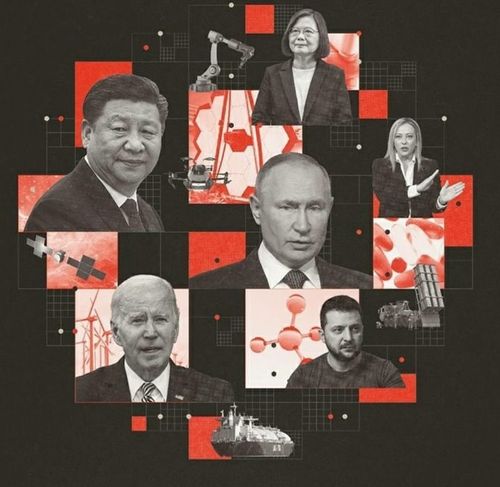Wars, death, hydrocarbons, the struggle for power, aftershocks and unpredictability - these will be the main trends of 2023, according to The Economist. Its new cover features the leaders of six world countries, i.e. the US, China, Russia, Ukraine, Italy and Taiwan.
Disclaimer: This text was contributed by CEO Cryptorg Andrey Podolyan. The views, thoughts, and opinions expressed in the article are the author's own and do not reflect the opinion of the editorial.

Why does The Economist's cover attract so much attention every year? The reason leads to a widespread opinion that the Secret World Government every year tries to convey to mankind through the cover of The Economist what is intended to happen. We can laugh at conspiracy theorists, but it's even harder to deny the amazing ability of the Economist's build editors to predict the future.
Let's look at a few clear examples of how The Economist's covers became prophecy in recent years. So, the magazine's cover for 2019 featured the Four Horsemen of the Apocalypse on the horizon. One of them, the American Statue of Liberty, was shown wearing a medical mask. This was depicted at the end of 2018, when no one thought at all about the virus, the pandemic and the very possibility of lockdowns.

The Economist's 2020 cover depicted letters and numbers, including four numbers of the upcoming year, 2020. First two digits were shown in red, while the second two coloured in green. Although the cover was published in November 2019, when no one knew about the coronavirus yet, it no longer depicted a pandemic. The pandemic was already a fait accompli. The Economist's 2020 cover predicted the state of financial markets, which fell in the first half of 2020 and rose rapidly in the second half of the year.

The cover of 2021 depicts a slot machine. This is how the Economist saw 2021. That year was like a casino with unpredictable results. The cover is decorated in yellow and red colors that scream: "Attention, danger!". Now, looking into the past, it becomes clear that all the events of 2022 were already known at the end of 2020.
It was the time when the die was cast. All the next year had to do was watch the dice fall.

At that time, many saw this as a sign that the number of people involved in the stock market games would grow. Now it is clear that it was not about the exchange game, but about the global games, with the world economy, social stability and human lives being its stake.
The Economist's 2022 cover captures the full meaning of this year. The whole world is in free fall down the rabbit hole in an attempt to find out how deep it goes. We see how the rabbit hole, like a black hole, sucks in known financial instruments, fiat currencies and cryptocurrencies suggesting that there is a mutual guarantee of debt obligations. Alice, who clearly symbolizes the humanity, watches the process with interest. Now, after the collapse of the FTX crypto exchange, this cover seems eerily prophetic.
Let's go back to The Economist's 2023 cover. It is depicted in red and black colors. Red is the color of blood, rage, war and falling markets. We have seen all these disasters this year. Black is the color of oil, the color of the unknown space, as well as the earth and the traditional color of death in Western European culture - in defiance of Eastern culture, where white is considered mourning. Conflicts will continue, markets will be in a fever, the struggle will engulf the whole world and even space, and will also become a special test for Western European civilization.
The globe, like last year, is made in the form of Pac-Man. It will continue to absorb the economies of various countries.
The six politicians featured on the cover will be of paramount importance in 2023 for the whole world. We witness here the main storylines of the world conflict: Russia and Ukraine, Russia and the USA, the USA and China, China and Taiwan. And all this amid the growing influence of center-right and far-right political forces in Europe, which is hungry for politicians who put their own national interests and the prosperity of their people first.
Fasten seat belts. 2023 will be challenging.

